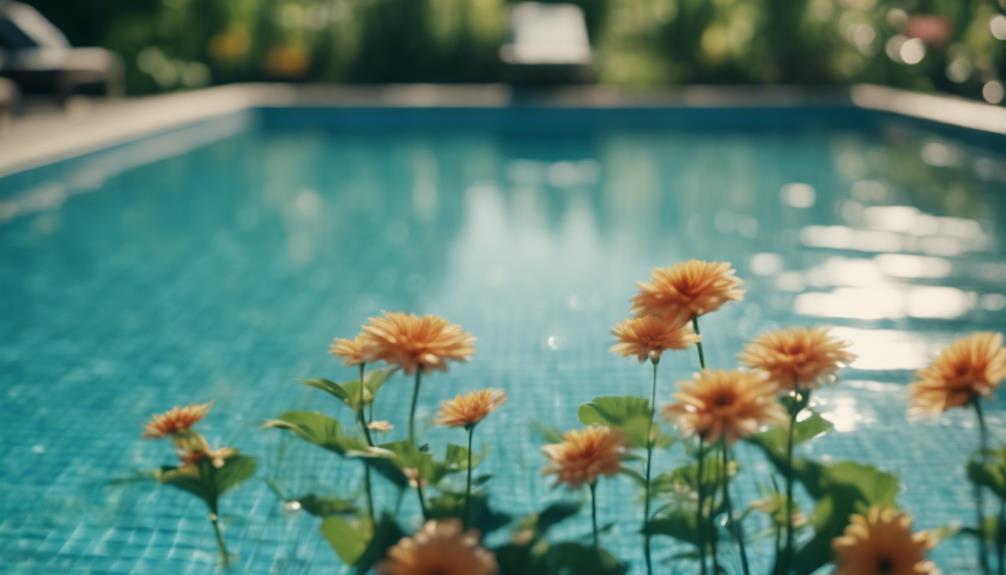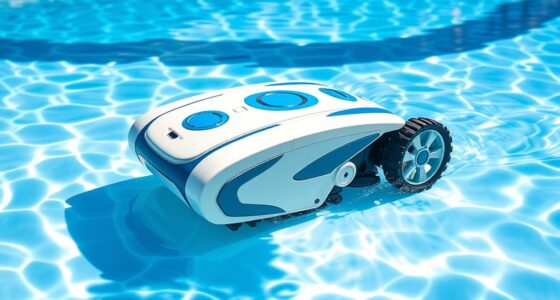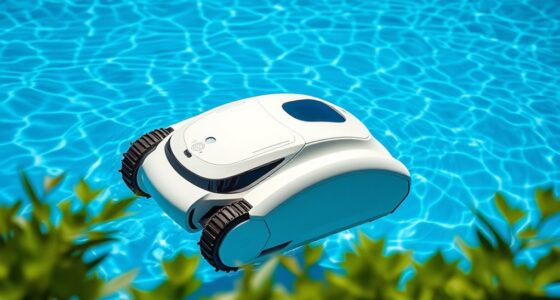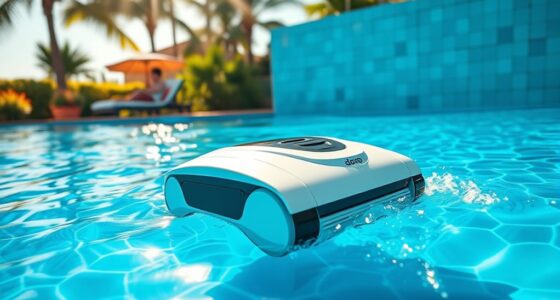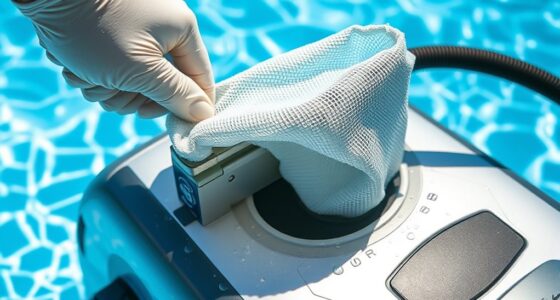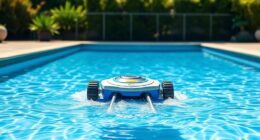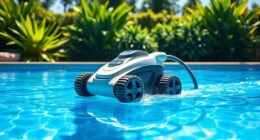In order to achieve a perfectly clear blue color in your pool, factors such as sunlight reflection and control of algae are crucial. The presence of algae can cause your water to turn green or brown, while chemical imbalances can result in off-color water. It is important to closely monitor the pH, chlorine, alkalinity, and calcium hardness levels in your pool. To prevent algae growth, use algaecides, regularly brush and vacuum your pool, maintain proper chlorine levels, cover your pool when not in use, and keep the pH balanced. Make sure to regularly test and adjust chemical levels, clean the filter, and keep the water circulating. Remember, maintaining the pH balance is essential for clear water. Keeping your pool water a sparkling blue requires meticulous attention to chemical balance and consistent maintenance. The color of your pool is a reflection of the care you provide.
Key Takeaways
- Maintain proper pH levels between 7.2-7.6 for blue water.
- Regularly test and adjust chlorine levels for clarity.
- Ensure correct total alkalinity (80-120 ppm) for stable pH.
- Use algaecides and regular cleaning to prevent algae growth.
- Consistent filtration and cleaning schedule for crystal clear water.
Reasons for Blue Water
When it comes to understanding why swimming pool water turns blue, it's all about the interplay of light and water chemistry. The blue color you see in pool water isn't a mere coincidence but a result of the water's unique properties.
Pool water appears blue because it reflects the sky and absorbs other colors, leaving the blue hue to dominate. This effect gives off a clean and inviting vibe, reminiscent of a day at the beach or a serene ocean.
Contrary to popular belief, the color of the pool walls doesn't influence the water's blue appearance. Instead, it's the water itself that interacts with light to create this calming color. The sun's rays play an essential role in this process, causing the water to absorb all colors except blue, resulting in the familiar blue pool water you enjoy.
Factors Affecting Water Color
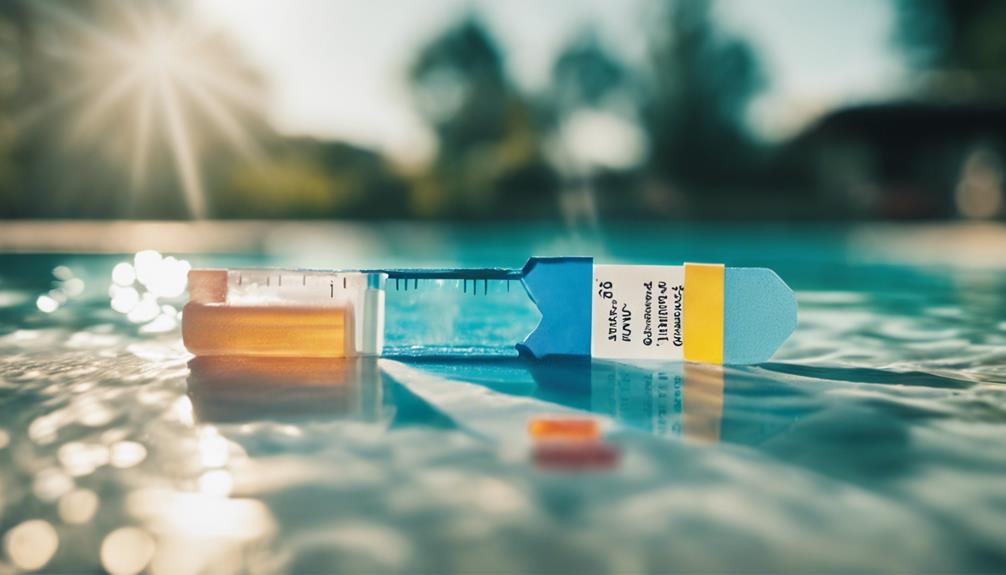
High algae levels, chemical imbalance from cleaning agents, and faulty filter systems are some factors that can impact the color of your pool water.
Algae growth in your pool, often due to high organic content or surrounding plants, can lead to green or brown water, indicating the necessity for proper cleaning and maintenance.
Additionally, a chemical imbalance caused by cleaning agents may result in cloudy or off-colored water, signaling the significance of using the right products for your pool type.
Furthermore, a faulty filter system can introduce murky water into your pool, affecting its clarity and color.
To guarantee your pool water remains crystal clear, it's important to regularly clean your pool floor, monitor the type of pool you have, and make sure to use appropriate cleaning and maintenance products.
Chemical Imbalance Effects

Maintaining proper chemical balance in your swimming pool is vital to guarantee water clarity and the safety of swimmers.
When pH levels are off, your pool water can become cloudy, causing potential skin irritation. Fluctuating chlorine levels not only harm swimmers but also lead to cloudy water.
High total alkalinity levels can hinder the dissolution of lime, resulting in murky water that obscures the pool wall and the bottom of your pool. Additionally, increased calcium hardness can cause cloudiness and clog your filters, impacting the overall cleanliness of your pool.
It's essential to make sure that you use chemicals correctly, as improper usage can foster bacterial growth and contribute to cloudiness in your pool water. Remember, the chemicals you add should be proportional to your pool's volume to maintain a healthy and clear swimming environment.
Understanding Pool Chemicals

To guarantee your swimming pool water stays clear and safe for swimming, it is essential to understand the roles of different pool chemicals. Properly balanced pool chemicals, including chlorine, pH, alkalinity, and calcium hardness, play an important role in maintaining the clarity and quality of your pool water. Neglecting these chemicals can result in cloudy, green, or brown water, making it unsafe for swimming. Regular testing and adjustment of pool chemicals are necessary to make sure the water remains blue and inviting. Check out the table below to learn about the functions of each pool chemical and how they contribute to a sparkling pool in the long run.
| Pool Chemical | Function | Importance |
|---|---|---|
| Chlorine | Kills bacteria and algae | To make sure water is safe for swimming |
| pH | Maintains water balance | To ensure chemical effectiveness |
| Alkalinity | Prevents pH fluctuations | To avoid skin irritation and equipment damage |
| Calcium Hardness | Protects pool surfaces and equipment | For the long run maintenance |
| Stabilizer | Protects chlorine from sunlight degradation | To prolong chlorine's effectiveness |
Algae Removal Techniques
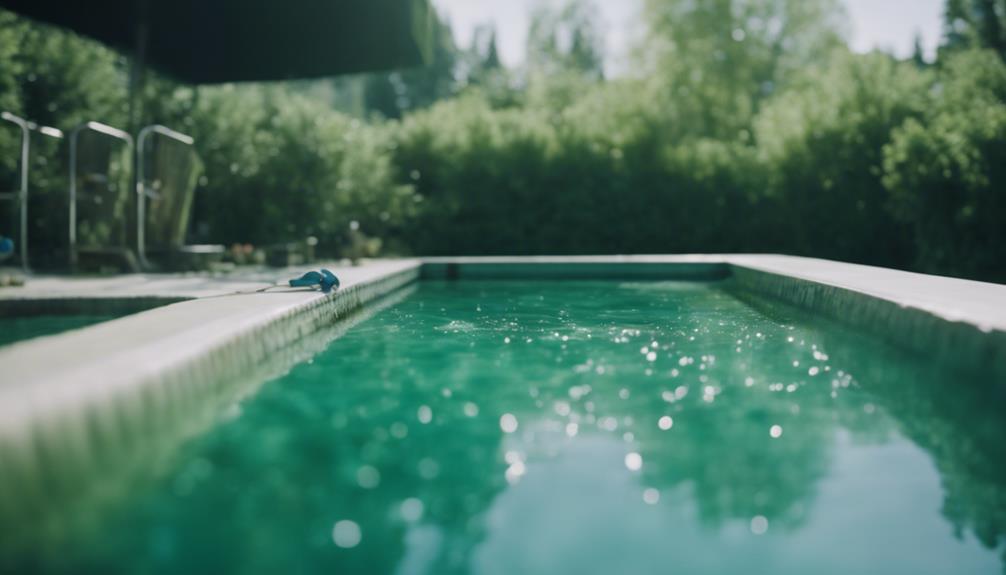
Understanding the importance of algae removal techniques is key to maintaining a clear and inviting swimming pool environment. To effectively combat algae in your pool water, consider using algaecides. These products are designed to kill existing algae and prevent its further growth.
Additionally, make sure to regularly brush and vacuum your pool to remove any algae spores present and prevent their spread. Maintaining proper chlorine levels is vital as it inhibits algae growth and helps keep your pool water blue and sparkling.
Since algae thrives in sunlight, a practical tip is to use a pool cover when the pool isn't in use to limit its exposure. Monitoring and balancing the pH levels in your pool is essential. Algae tend to flourish in unbalanced water conditions, so by keeping the pH levels in check, you can create an environment less conducive to algae growth.
Preventing Algae Growth
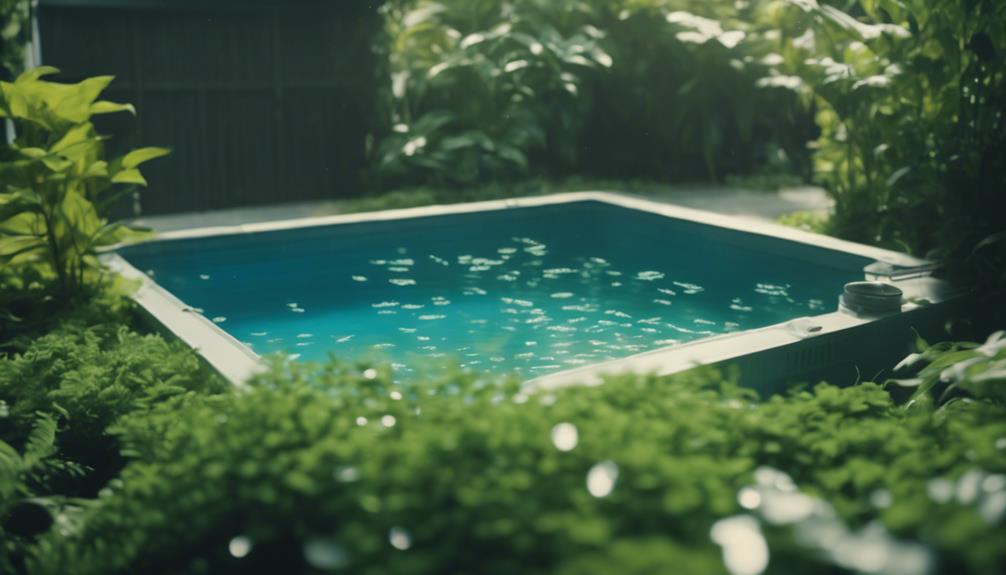
Algae growth in pools can be effectively prevented by guaranteeing proper circulation and filtration of the water. To maintain crystal-clear blue water in your pool, follow these essential tips:
- Maintain Proper Chlorine Levels: Adequate chlorine levels help prevent algae growth and guarantee water clarity.
- Regularly Circulate Water: Algae thrives in stagnant water, so guarantee proper circulation to deter growth.
- Utilize Algaecides: Adding algaecides can help control algae blooms and keep your pool water clean.
- Keep Pool Surfaces Clean: Regularly brushing and cleaning pool surfaces can prevent algae buildup.
- Monitor pH Levels: Maintaining balanced pH levels inhibits algae growth and helps preserve the desired blue color of your pool water.
Balancing Pool Chemicals
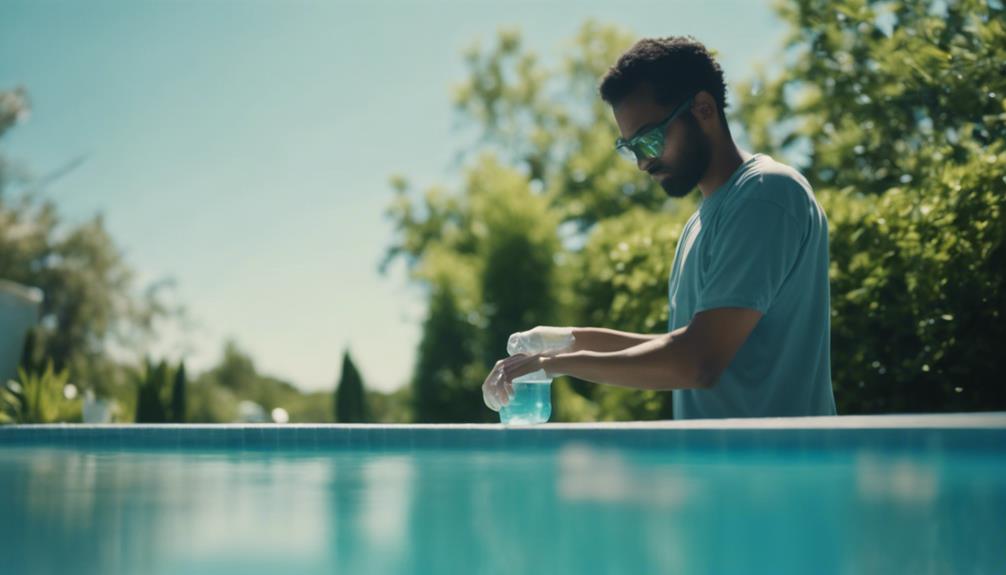
To maintain the vibrant blue color of your pool water, it's essential to pay attention to the pH levels, ensuring they're within the recommended range to prevent skin irritation and preserve the water's hue.
Proper chlorine dosage is vital in preventing cloudiness and maintaining the blue appearance of the water, so regularly testing and adjusting it's key.
Additionally, monitoring total alkalinity levels is important to prevent lime buildup and keep your pool water crystal clear and blue.
Ph Level Importance
Maintaining proper pH levels in your swimming pool is essential for ensuring clear and inviting water. Here are some key points to keep in mind when it comes to the significance of pH balance:
- Ideal Range: The recommended pH range for pool water is 7.2-7.6, which helps maintain water clarity and comfort for swimmers.
- Effects of Imbalance: pH levels outside this range can result in cloudy water, skin irritation, and reduced effectiveness of chlorine sanitation.
- Regular Testing: Testing your pool water frequently with a pH testing kit allows you to identify any imbalances that could impact water quality.
- Consequences of Imbalance: Acidic water (low pH) can lead to equipment corrosion, while alkaline water (high pH) can cause scaling and cloudiness.
- Balancing Act: Balancing pH levels by adding pH increasers or decreasers based on test results is essential for achieving crystal clear and inviting pool water.
Chlorine Dosage Tips
Balancing pool chemicals, such as chlorine dosage, plays an important role in maintaining the clarity and cleanliness of your swimming pool water. Proper chlorine levels are essential for sanitizing and disinfecting the water effectively, preventing algae growth, and ensuring a safe swimming environment.
To maintain ideal chlorine levels, use chlorine test kits regularly to monitor and adjust within the recommended range. Over-chlorination can lead to skin and eye irritation, while under-chlorination may result in bacterial and algae growth, compromising water quality.
Understanding the correct chlorine dosage based on your pool size and usage is essential for achieving and sustaining crystal clear, blue pool water. By following recommended chlorine dosage tips and regularly testing and adjusting chlorine levels, you can enjoy a sparkling clean pool that's safe for swimming.
Alkalinity Testing Methods
When testing alkalinity in your pool water, use a test kit to measure total alkalinity levels in parts per million (ppm).
Maintaining ideal alkalinity levels is essential for ensuring your pool water stays clear and balanced.
Here are five essential tips for testing and adjusting alkalinity in your swimming pool:
- Aim for total alkalinity levels between 80-120 ppm to keep pH stable.
- Low alkalinity can lead to pH fluctuations and corrosion, while high levels can cause cloudiness and scaling.
- Use alkalinity increaser or reducer products to adjust alkalinity levels as needed.
- Regularly monitor alkalinity levels to prevent water imbalances and maintain clarity.
- Remember that keeping alkalinity in check is key to a healthy and enjoyable swimming experience.
Pool Maintenance Tips
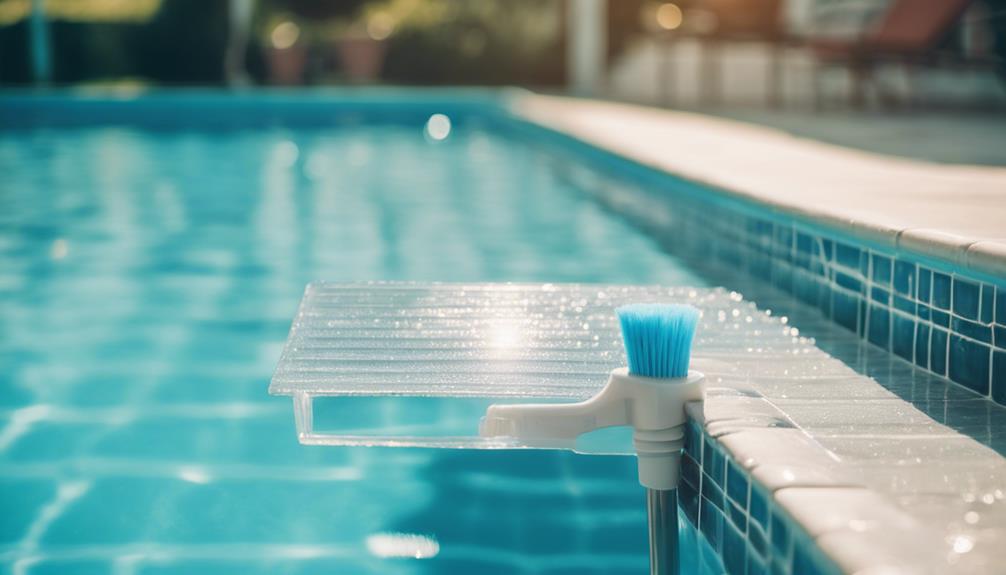
To maintain your pool's vibrant blue color, it's important to balance the water's pH levels, regularly clean the pool, and guarantee proper chlorine levels.
Keeping a consistent filtration schedule will help in maintaining the clarity and color of your pool water.
Check and adjust these key factors regularly to enjoy a sparkling blue pool all season long.
Water Ph Balance
Maintaining the proper pH balance in your swimming pool is essential for keeping the water clear and blue. Here are some key points to keep in mind:
- The ideal pH range for pool water is between 7.2 and 7.6 to prevent cloudiness and skin irritation.
- Regularly test the pH levels using a testing kit to determine if adjustments are needed.
- Use chemicals like muriatic acid or soda ash to balance the pH levels accordingly.
- Imbalanced pH levels can lead to water discoloration and affect the effectiveness of chlorine in sanitizing the pool.
Regular Filtration Schedule
Regularly running your pool filter for 8-12 hours a day is essential for maintaining clean and clear water. By adhering to a consistent filtration schedule, you allow the filter to effectively remove debris, dirt, and contaminants, ensuring that your pool water remains crystal clear. Remember, keeping your pool filter clean is just as important.
Whether through backwashing or cleaning the cartridges, maintaining a clean filter optimizes filtration efficiency.
To prevent algae growth and maintain the desired blue hue of your pool water, it's necessary to check and maintain your filtration system monthly. This regular maintenance helps guarantee that the filtration system is functioning correctly, contributing to the overall clarity and cleanliness of your pool water.
Chlorine Levels Control
Check and maintain your pool's chlorine levels regularly to guarantee your water stays clear and blue. Here are five essential tips for controlling chlorine levels in your swimming pool:
- Test chlorine levels frequently using reliable test strips or kits to verify they're within the recommended range.
- Adjust chlorine levels as needed by adding chlorine granules or tablets to the water to maintain the ideal balance.
- Monitor for signs of high chlorine levels such as strong chemical odors or irritation to skin and eyes, and take corrective measures promptly.
- Be wary of low chlorine levels, which can result in algae growth and cloudy water, indicating the need for additional chlorine.
- Remember to balance chlorine levels with other chemicals like pH and alkalinity to create a harmonious environment for crystal clear, blue water.
Troubleshooting Cloudy Water
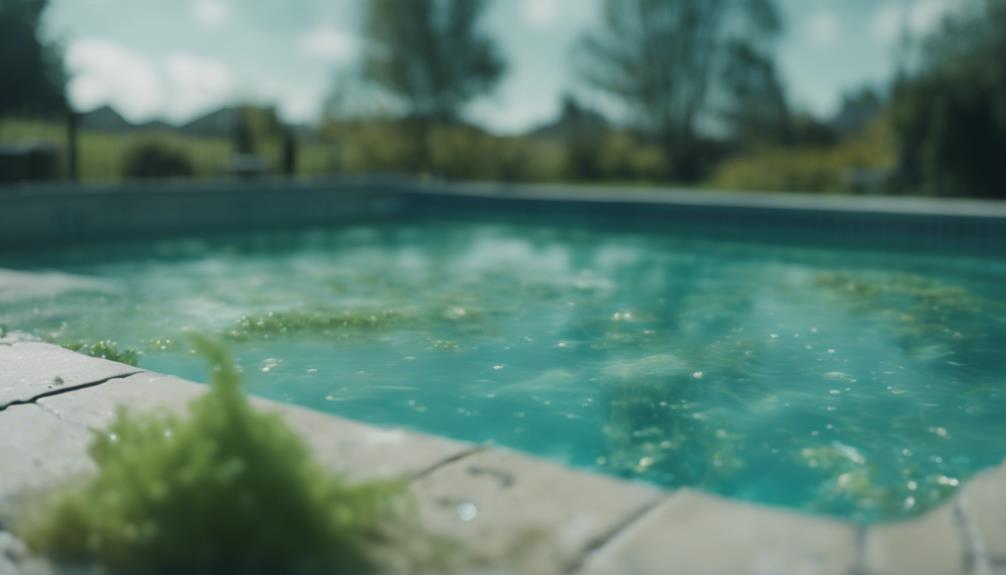
To troubleshoot cloudy water in your swimming pool, start by testing the chemical levels for total alkalinity and chlorine. Cloudiness can often be attributed to imbalances in these key factors.
High total alkalinity or fluctuating chlorine levels are common culprits that lead to murky pool water. Additionally, faulty filters can introduce impurities, further contributing to cloudiness. Algae growth, fueled by organic matter or nearby plants, can also play a significant role in causing water cloudiness.
Regular maintenance is vital in combating cloudy water; this includes draining, scrubbing, and refilling the pool as needed. Utilizing test kits to identify and correct any chemical imbalances is essential for maintaining crystal clear water in your pool.
Frequently Asked Questions
How Do I Make My Crystal Clear Blue Pool Water?
To maintain crystal clear blue pool water, focus on proper chemical balance by monitoring and adjusting chlorine, pH, total alkalinity, and calcium hardness levels.
Regularly clean your pool through scrubbing, filtering, and refilling to prevent algae growth.
Use chemical identification kits to detect imbalances and take necessary actions.
Confirm your pool filter functions efficiently to prevent murky water.
Avoid introducing organic matter like leaves to prevent discoloration and algae growth.
How to Turn Your Pool Water Blue?
To turn your pool water blue, consider adding a blue pool dye or installing blue LED lights for a vibrant color. Maintaining proper pH, chlorine, alkalinity, and calcium levels is essential.
Using pool clarifiers and algaecides can prevent discoloration. Make sure your filtration system is working efficiently and clean your pool regularly to keep the water crystal clear and blue.
Following these steps will help you achieve and maintain a beautiful blue pool.
How Do I Add Super Blue to My Pool?
To add Super Blue to your pool, first, determine the appropriate dosage based on your pool's size and water condition. Typically, you'll pour the recommended amount of Super Blue directly into the pool water.
Allow the product to circulate for a few hours or overnight for best results.
Regularly monitor your pool's chemical levels and adjust as needed to maintain the desired clarity and color.
How Long Does It Take for Pool Water to Turn Blue?
It typically takes 24-48 hours for pool water to turn blue after adding the necessary chemicals. Factors like pool size, water volume, and initial water condition can affect this timeframe.
Proper circulation and filtration systems can expedite the process.
Regular monitoring of chemical levels and adjustments are important for maintaining the blue color.
Consistent maintenance and cleaning practices play an essential role in keeping your pool water crystal clear and blue.
What Are the Best Methods to Turn Pool Water Blue?
There are several easy steps for blue pool water. First, make sure to regularly clean and skim the pool to remove any debris. Second, balance the pH and chlorine levels to prevent algae growth. Lastly, consider using a pool shock treatment to maintain a beautiful blue hue in your pool water.
Conclusion
To achieve crystal clear blue water in your swimming pool, it's essential to maintain proper chemical balance, regularly remove algae, and follow a consistent maintenance routine.
By understanding the factors that affect water color and taking proactive steps to prevent issues, you can enjoy a beautiful and inviting pool all season long.
Remember, clear blue water isn't just a visual pleasure, but also a sign of a healthy and well-maintained swimming pool.

